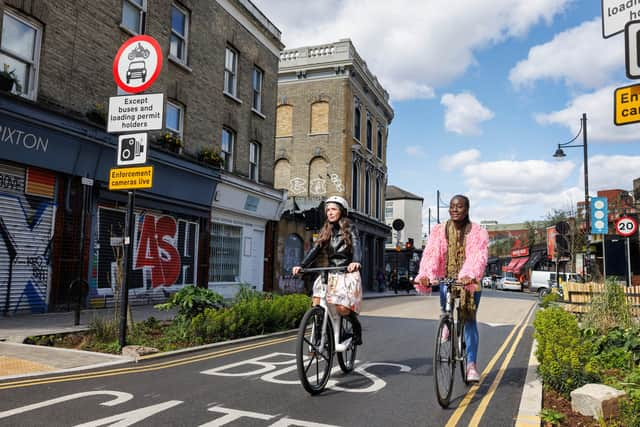Rishi Sunak and LTNs: Prime minister orders review of schemes - do they reduce traffic in London?
and live on Freeview channel 276
Low-traffic neighbourhoods, or LTNs, have once again been thrust into the limelight after prime minister Rishi Sunak said he would be ordering a review into the schemes across the country.
In an interview with the Sunday Telegraph, Mr Sunak said he wants to support people to “use their cars to do all the things that matter to them”.
Advertisement
Hide AdAdvertisement
Hide AdThe schemes, which use barriers such as planters, bollards or cameras plus measures including road closures to manage traffic levels in certain areas, have been the subject of numerous demonstrations and protests over their perceived impacts on motorists, local businesses and other concerned groups.
While they do not prevent access to homes or totally ban cars, they are designed to prevent rat-running, while also improving the health and safety of a neighbourhood.
Former Conservative prime minister, Boris Johnson, was a staunch supporter of the schemes during Covid, providing additional funding to councils to roll them out.
However, Mr Sunak has chosen to adopt a different approach, and has now called for a review of all LTNs in England.
Advertisement
Hide AdAdvertisement
Hide AdBut what is the impact of London’s LTNs on motor traffic? And are they ‘anti-motorist’?


‘Little impact’ on boundary roads
One of the most common concerns raised about LTNs is that they simply push traffic onto other, nearby roads, and so just displace the pollution elsewhere.
In an interview with LondonWorld earlier this year, Rachel Aldred, a professor of transport at the University of Westminster and director of the university’s Active Travel Academy, listed this claim as one of the key misconceptions related to LTNs.
She said that, rather than traffic levels remaining the same, they are subject to change depending on the context and decisions made available to people.
Advertisement
Hide AdAdvertisement
Hide AdFor example, when bus services are improved, as they were in London in the early 2000s, “suddenly, you will get a lot more people travelling by bus because it’s become more attractive than the other options - because somehow, suddenly, they can get to places they wouldn’t be able to get before”.


While this does not mean every LTN in the capital is successful, Professor Aldred said the principle that when traffic is restricted in an area it automatically appears elsewhere is incorrect.
And research from the start of the year appears to back this claim. In January, the climate charity Possible published a study, part-authored by Professor Aldred, analysing data from 46 schemes in 11 London boroughs introduced between May 2020 and May 2021.
In their research, they found that there was “little indication” that the LTNs displaced traffic onto boundary roads.
Advertisement
Hide AdAdvertisement
Hide Ad“Average motor traffic counts showed that on boundary roads, traffic changed relatively little,” the authors wrote, “with a less than 1% increase on the mean average of 11,000 vehicles that pass through boundary roads on a typical day”.
Reductions in overall driving
In the same study, the authors wrote that overall traffic within the LTNs dropped substantially. Two-thirds of the neighbourhoods observed recorded vehicle flows of below 1,000 a day, compared to just two-fifths before, while across London, the average traffic reduction was 46.9%.
A separate study on LTNs in Lambeth, authored by academics again including Professor Aldred, also found they successfully cut the amount driven by residents living within the zones.
In the year to March 2023, the data showed that those living in the LTNs were driving 0.7km less daily than in 2020, while residents in the wider control area recorded an increase of 0.6km.
Advertisement
Hide AdAdvertisement
Hide AdTotalling a difference of 6.4% between the two groups, the researchers wrote: “In summary, our findings suggest that residents in Lambeth started driving less once their area became an LTN.”
They added the changes appeared to be behavioural, with the same residents cutting down on their driving rather than frequent car users moving elsewhere.
How popular are LTNs among Londoners?
Polling from earlier this month indicated more Londoners are in favour of LTNs than opposed.
Undertaken by Redfield and Wilton Strategies, the survey of 1,100 of the capital’s residents found that 58% of respondents are in-favour of the introduction of the schemes, with just 17% opposed.
Advertisement
Hide AdAdvertisement
Hide AdOther local consultations have also indicated support over time. Cllr Clyde Loakes, Waltham Forest Council deputy leader and cabinet member for climate and air quality, previously told LondonWorld: “Our first LTN in Orford Road, Walthamstow, experienced protests as it was being introduced claiming businesses would have to close and residents would be forced out.
“Now, however, the area is thriving. Only 1.7% of respondents wanted the scheme to be removed in a survey conducted a year after it was created, compared to 55% who said they would not change it.”
The support has not been absolute, however, with some schemes scrapped due to poor implementation and local backlash.
Southwark Council recently binned plans to introduce a new LTN in Dulwich Village, after a survey found “limited support” for the proposals.
Advertisement
Hide AdAdvertisement
Hide AdWhat else did Rishi Sunak say?
Beyond LTNs, Mr Sunak has said he will take a “proportionate and pragmatic” approach to net-zero, which the UK aims to meet by 2030.
He has committed to hundreds of new oil and gas licences in the North Sea, a move met with dismay by green campaigners.
UK Prime Minister Rishi Sunak said: “We have all witnessed how Putin has manipulated and weaponised energy – disrupting supply and stalling growth in countries around the world.
“Now more than ever, it’s vital that we bolster our energy security and capitalise on that independence to deliver more affordable, clean energy to British homes and businesses.
Advertisement
Hide AdAdvertisement
Hide Ad“Even when we’ve reached net zero in 2050, a quarter of our energy needs will come from oil and gas. But there are those who would rather that it come from hostile states than from the supplies we have here at home.
“We’re choosing to power up Britain from Britain and invest in crucial industries such as carbon capture and storage, rather than depend on more carbon intensive gas imports from overseas – which will support thousands of skilled jobs, unlock further opportunities for green technologies and grow the economy.”
The Conservatives’ has turned to environmental policies following the Uxbridge and South Ruislip by-election victory.
The result was seen as a response to London mayor Sadiq Khan’s Ultra Low Emission Zone (ULEZ) expansion, despite the Tories’ majority slipping from more than 7,000 to just 495.
Advertisement
Hide AdAdvertisement
Hide AdRecent research by YouGov and analysed by the Financial Times, however, suggests there is general public support for green policies among the British public, with UK Conservatives often as green as the centre-left in peer counties.
Comment Guidelines
National World encourages reader discussion on our stories. User feedback, insights and back-and-forth exchanges add a rich layer of context to reporting. Please review our Community Guidelines before commenting.
